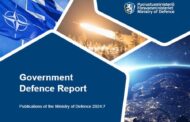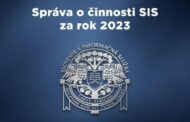Zástupca generálneho tajomníka NATO Alexander Vershbow predniesol 1. septembra 2016 na výročnom letnom summite Fínskeho inštitútu medzinárodných vzťahov prejav „NATO v transatlantickej bezpečnostnej politike“. Prejav publikujeme v plnom znení.
* * * * *
NATO in Translatlantic Security Policy
_______________________________________________________________________________________________________
Keynote Address by NATO Deputy Secretary General Ambassador Alexander Vershbow at the 3rd Annual Helsinki Summer Session
Finnish Institute of International Affairs,
Helsinki, 01 Sep. 2016
It’s a great pleasure to be back in Helsinki and to participate in FIIA’s third annual conference.
Helsinki has always held a special attraction for me – and not only because my wife and I spent several enjoyable weekends here during our first posting to Moscow in the 1970s, when this was the nearest oasis from the bleak Soviet Union of the late Brezhnev period.
Since my graduate school years in the mid-1970s, I have associated Helsinki with the Helsinki Final Act, signed on August 1, 1975 in Finlandia Hall after three long and difficult years of negotiation.
This far-reaching agreement marked a major turning point in the Cold War. It did much more than recognise the post-World War II borders in Europe. It also represented a sharp break from the concept of an ideologically divided Europe enshrined by the Yalta Conference in 1945, and served as the foundation for East-West détente and reconciliation.
Most importantly, Helsinki committed all signatory nations to respect important values like the peaceful resolution of disputes, human rights and the rule of law – many of the same values, in fact, that have animated the NATO Alliance since our founding in 1949.
And that pledge helped to unleash the pro-democracy transformation of Eastern Europe that ultimately culminated in the fall of the Berlin Wall, the demise of the Warsaw Pact, and the peaceful dissolution of the Soviet Union.
Very impressive achievements by any standard!
Throughout my diplomatic career, the Helsinki Final Act has represented something close to the gold standard of the positive good that can be achieved through dogged, determined and enlightened diplomacy.
And so, with that in mind, I am very pleased that one of my final acts as Deputy Secretary General of NATO is to speak here in Helsinki at this important conference.
I appreciate the opportunity to share a few thoughts with you about the evolving challenges that confront NATO today; about the steps NATO has been taking – especially at our two most recent summits in Wales and Warsaw – to address those challenges; and about the enduring values that continue to unify our Alliance, along with our many partners, including, of course, Finland.
On that last point, I want to express my deep appreciation to Finland for being such a valued and effective NATO partner over the years. Among many other things, Finland has contributed to a wide spectrum of activities, including NATO-led operations and missions in the Balkans and Afghanistan, participation in the NATO Response Force, valuable training for the forces of NATO partner countries, and human security.
Finland has also supported several concrete NATO-led Trust Fund projects – including with Ukraine and Georgia – aimed at promoting defence and security reforms in these strategically important countries.
Following our Wales Summit in 2014, Finland became one of NATO’s Enhanced Opportunities Partners (or EOPs), which means more co-ownership, more dialogue on cooperative security, and more interaction together. Since the launch of the EOP initiative, we have been working more closely with Finland on many challenges, including Baltic Sea security.
NATO values this relationship very highly. And Allies were extremely pleased that both Finland and Sweden participated so extensively in the Warsaw Summit – notably at the heads of state dinner where leaders discussed relations with Russia.
As Secretary General Stoltenberg quipped at the dinner itself: It’s up to Finland and Sweden to decide if they’re interested in more than dinner. There are many options on the menu.
EOP status enables NATO and Finland to consult politically at the highest levels, to share intelligence and develop joint situational awareness both militarily and politically, and in a broader sense, to work in concert to address common security challenges.
I’ll come back a bit later to the vital role partners play within NATO. But first, I want to turn to the evolving security challenges that NATO and our partners face today and discuss the steps NATO has been taking to address them.
It is no exaggeration to say that NATO is confronting the most dangerous and unpredictable security situation since the height of the Cold War: from an evolving set of challenges right here in the Baltic Sea region, to the Black Sea area, the North Atlantic, the Mediterranean, and to the arc of instability and turmoil across much of the Middle East and North Africa.
2014 stands out as a watershed year. Looking to the east, with its illegal annexation of Crimea, Russia effectively tore up the Helsinki-based international rulebook and challenged our post-Cold War vision of a Europe whole, free and at peace.
For the first time since 1945, a European power sought to change international borders by force. Two years later, we face continued Russian aggression in Eastern Ukraine, as well as brutal efforts to consolidate control over the occupied Crimean peninsula of Ukraine.
The difficulties in our relations with Russia did not, of course, begin in 2014. Over the past decade Russia has been conducting a substantial military buildup, and it showed a willingness to use force against its neighbours in 2008, in its war with Georgia. Moreover, Russia has employed subversion, propaganda and cyber-attacks to test our readiness and resolve.
Together with its aggression against Ukraine, Russia’s decision to abandon the Conventional Forces in Europe Treaty and its dismal record of implementing the other long-standing international security agreements – including the Vienna Document, the Open Skies Treaty, the Helsinki Final Act and the NATO-Russia Founding Act – have raised tensions to a level not seen since the 1980s.
To the South, terrorism and chaos clearly didn’t begin in 2014 either. But that year witnessed a step change – for the worse – with the emergence of the so-called Islamic State or Da’esh, and its declared ambition to establish a caliphate, beginning in Iraq and Syria.
ISIL’s seizure of territory and its reign of terror contributed to the escalation of the civil war in Syria, a worsening string of crises across the Middle East and North Africa, a series of terrorist attacks in several NATO countries, and the biggest migrant and refugee crisis in Europe since World War II.
In addition to these major challenges to the East and South, NATO continues to face longstanding threats such as cyber attacks, hybrid warfare, nuclear proliferation, and the spread of long-range ballistic missiles.
Our Wales Summit in 2014 was NATO’s initial response to these evolving threats, under the banner of the Readiness Action Plan (or RAP). For example, the NATO Response Force is now three times bigger, with a brigade-sized high-readiness Spearhead Force (the VJTF) at its core, able to move within a matter of days wherever it may be required.
In the two years since Wales, we also set up a series of small headquarters in the eastern part of our Alliance, increased the number and scope of our exercises, and sped up decision-making in order to respond to potential hybrid forms of aggression, as seen in the annexation of Crimea.
But as I said, Wales was just the initial response. At the Warsaw Summit two months ago, we took additional decisions to strengthen our deterrence and defence posture for the longer term, reflecting the enduring nature of the threats and challenges we face – to the east and to the south.
As has been widely reported, we decided to enhance the forward presence of NATO forces in the eastern part of the Alliance, with four battalion-sized battle groups in Estonia, Latvia, Lithuania and Poland. These defensive battalions will be rotational and multinational, and robust enough to make clear that an attack against one Ally will be met by forces from across the Alliance. They will ensure we have sufficient time for the Spearhead Force and other reinforcements to arrive.
In addition, we agreed on a tailored forward presence for our south-eastern flank, with a land element built around a multinational framework brigade in Romania. This will be supplemented by steps to strengthen the readiness and interoperability of air and maritime forces in the Black Sea region.
We also took steps to enhance our resilience, both within our nations and collectively. This includes modernising our capabilities, improving civil preparedness, and ensuring we have the right mix of military and civilian capabilities to meet evolving security challenges, including hybrid and cyber warfare.
Some fear many of these measures represent a dangerous tit-for-tat military escalation with Russia. I disagree. The simple fact is all of NATO’s measures are defensive, proportionate, transparent and fully in line with our international obligations.
These efforts are meant to deter aggression – to prevent conflict, not to provoke it. NATO poses no threat to Russia or to any other country. We do not seek confrontation or a new arms race. But we have an obligation to protect our people and defend our allies. That, after all, is our main raison d’être.
Despite our differences with Russia, it is essential that we engage constructively. That’s why we are pursuing a two-track approach: defence combined with dialogue – not to return to business as usual, while Russian aggression against Ukraine continues, but to address our differences and to prevent tensions from getting out of hand.
In the two NATO-Russia Council meetings held this year, Allies have put particular stress on the need for Russia to agree to measures to increase military transparency and risk reduction. At the second NRC meeting in July, Russia raised the issue of the use of transponders by military aircraft in the Baltic. While we welcome Russian willingness to discuss risk reduction, ensuring air safety is far broader than this one issue. It’s also about following the rules we already have and behaving in a safe, responsible and predictable manner.
We’re looking at how we can build on this proposal while also making clear to Russia the importance of making progress in other areas relating to transparency and risk reduction, including amendments to the Vienna Document, such as closing the loophole for no-notice “snap” inspections that Russia has been conducting with increasing regularity.
In addition to strengthening our defence and deterrence posture, at the Warsaw Summit we also decided to project greater stability beyond our borders, to the east and south. The way we see it, if our neighbours are more stable, then we are more secure. We have begun to adapt our strategy on cooperative security, partnerships and capacity building to the new reality we confront today.
To this end, we re-affirmed our commitment to our partners in the east – Ukraine, Georgia and the Republic of Moldova – to help them resist outside pressure and advance crucial defence and security reforms. In the case of Ukraine, we agreed on a Comprehensive Assistance Package, similar to the Substantial NATO-Georgia Package adopted at Wales two years ago.
In the Middle East and North Africa region, NATO is stepping up support for our partners to help them better secure their own countries and fight back against violent extremism. NATO is already training hundreds of Iraqi officers in Jordan, and this programme will now expand into Iraq itself. NATO stands ready, if requested, to help Libya develop effective defence institutions, to stabilise the country and better fight the Islamic State. We will also provide more support for Tunisia and Jordan, and we hope to establish closer institutional links to regional organizations such as the Gulf Cooperation Council and the African Union.
Afghanistan has been NATO’s largest operation outside Europe, and its now our largest defence capacity building mission. At the Warsaw Summit, NATO leaders agreed to continue our Resolute Support mission beyond 2016 and our contribution to funding the Afghan forces until 2020.
Needless to say, modernising our defence capabilities across the board requires investment – and all NATO countries understand this. At the Wales Summit, we agreed to stop the cuts in defence spending and to start spending more, with a goal of spending 2% of GDP on defence by 2024.
We are on the right track – defence spending among the European Allies plus Canada is slated to increase by 3% this year – but we have a long way to go. This is true for NATO members and NATO partners alike, which brings me back to the theme of partnerships and NATO’s special relationship with Finland within the EOP framework.
I’m convinced that our close association over the years with dozens of partners has helped to consolidate peace and stability in Europe, and to extend stability beyond our borders. It has been an integral part of the Alliance’s adaptation to changing circumstances and to meeting our primary obligation to defend our territories and our populations.
Today, I believe partnerships are a necessity, not a luxury. And we want our partners – including Finland – to be even more involved in what we do at a sensitive time, and on subjects very close to our “core business.”
So let me take a few moments to describe in more detail how NATO has deepened our cooperation with Finland and Sweden on security in the Baltic Sea region, and where this cooperation might go in the future.
Following the first political-military assessment of the Baltic Sea region – completed earlier this year as a 28+2 project – our objective is to continue to consult politically, share intelligence, develop a better situational awareness on evolving threats in the region, and work more effectively together to meet those threats.
An important priority for cooperation is to develop capabilities and maintain the ability of the Finnish armed forces to work with those of NATO and other partner countries in multinational peace-keeping operations – whether in a NATO, EU or UN context.
Interoperability is not just a military concept. It’s also important to achieve political interoperability through deeper cooperation on crisis management and contingency planning. Towards this end, Finland – as well as Sweden – participated in our annual Crisis Management Exercise, CMX 2016, earlier this year. This exercise included a simulated Article 5 collective defence response with challenges posed by hybrid warfare threats in the Baltic Sea area, complete with a range of realistic overt and covert military, paramilitary and civilian measures.
The inclusion of key partners reflected our shared security interests and demonstrated the potential added value to the Alliance of Finnish and Swedish contributions to defence and security in the Baltic region, even though these partners are not bound by NATO’s Article 5, mutual defence obligation.
Looking to the future, we could more closely integrate our defence and contingency planning, strengthen intelligence exchanges, and collaborate even more on transparency and risk reduction measures aimed at restoring predictability to our relations with Russia. We could also involve Finland and other close partners more intimately in our operational, training and exercises planning, and in our defence capacity building programmes for Ukraine and Georgia and for our Middle Eastern neighbours.
Finland can also play an active role from inside the European Union in expanding NATO-EU collaboration, building on the Joint Declaration signed in Warsaw by Secretary General Stoltenberg and Presidents Tusk and Juncker. And Allies could continue to benefit from Finland’s expertise in important areas such as civil preparedness, crisis management and hybrid warfare.
Of course, all of this cooperation would always be pursued in the spirit of a real co-ownership, respectful of Finland’s goals and desires as a militarily non-aligned country.
There will always be a line between members and partners, but there’s a great deal NATO and partners can do short of crossing that line to our mutual benefit. NATO looks forward to exploring these possibilities with Finland in near future.
Ladies and gentlemen,
In the preamble to the 1949 North Atlantic Treaty, NATO’s founding document, the twelve original signatory nations expressed their determination to “safeguard the freedom, common heritage and civilisation of their peoples, founded on the principles of democracy, individual liberty and the rule of law.”
Since 1949, NATO has helped to keep the peace in Europe by working closely with our partners and by forging an unbreakable bond of friendship and cooperation between Europe and North America. Our unity has been strengthened by our commitment to a common set of core values.
In a world with no shortage of challenges and a host of real and present dangers, the role NATO plays as a defensive bulwark of cooperative security cannot be underestimated. In the spirit of the Helsinki Final Act, let us do everything we can to strengthen our Alliance and our partnerships, to uphold our fundamental values, and to preserve the peace for future generations.
* * * * *
Text: ww.nato.int
Ilustračné foto:pixabay.com







